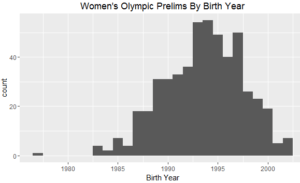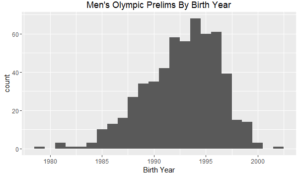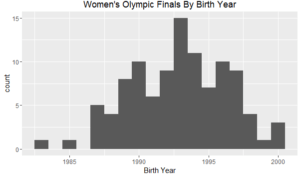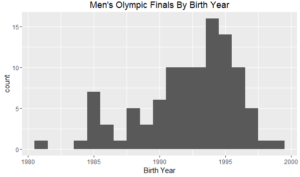Men peak later than women. Elite men’s swimmers are older than elite women’s swimmers. Those are assumptions most swim fans take as fact. At the 2012 Olympics, they appear correct. London medalists men were about 3 years older than medal winning women. This year was much closer with the men’s medal winners only about a year older than the women. The sample sizes are small enough that the changes might be explained by chance, but the idea that elite men are older than they used to be (at least older than 2012) seems far fetched.
(The Olympic results book doesn’t contain exact birth dates, but it does have birth years. Whenever I refer to an age I’m the taking Olympic year – birth year. If’s an athlete’s birthday is after the Olympics, this age might be off, but it will never be off by more than a couple months.)
The average birth year for swimmers with an individual event in Rio was 1992.7 for the men and 1993.8 for the women. The field as a whole was pretty similar in age to 2012, but the elite swimmer’s age’s changed noticeably. The average women’s medalist in 2012 was born in 1990.2 (“age” of 21.8) vs an average of 1993.0 in 2016 (“age” of 23.1). The 2012 group was made younger by the presence of young stars Missy Franklin and Katie Ledecky, but the average finalist (a larger group less influenced by outliers) was much younger in 2012 as well (23.1 vs 22.6). The men’s finalists and medalists were younger than in London, despite Michael Phelps (born in 1985) and Anthony Ervin (1981) winning 4 individual medals.
Here’s a comparison of average birth year in London vs Rio. The average for each round is over the birth year of all swims in that round, not all swimmers that were in that round. i.e. If a swimmer had 5 prelims swims, their birth year was in the average 5 times. This seemed most representative.
| Rio 2016 | London 2012 | |||
| Average Birth Year | “Age” | Average Birth Year | “Age” | |
| Prelims Men | 1992.7 | 23.3 | 1988.5 | 23.5 |
| Semifinal Men | 1992.1 | 23.9 | 1987.5 | 24.5 |
| Final Men | 1992.2 | 23.8 | 1987.5 | 24.5 |
| Medalist Men | 1991.8 | 24.2 | 1987.3 | 24.7 |
| Prelims Women | 1993.6 | 22.4 | 1990.1 | 21.9 |
| Semifinal Women | 1992.6 | 23.4 | 1989.3 | 22.7 |
| Final Women | 1992.9 | 23.1 | 1989.4 | 22.6 |
| Medalist Women | 1993.0 | 23.1 | 1990.2 | 21.8 |
Assorted fun facts:
-The oldest woman was Therese Alshammar of Sweden, born August 26, 1977 (Age 38). She was 12th in the 50 free prelims and 15th in the semi. The next oldest woman was Kirsty Coventry, age 32.
-The oldest man was Anthony Ervin of the USA, born May 26, 1981 (Age 35). He won gold in the 50 free and 4X100 free relay.
-The youngest men’s swimmer was Thint Myaat of Myanmar, born April 14, 2002 (Age 14). He was 43rd in the 100 fly. Myaat, was the only men’s swimmer born after the year 2000.
-The youngest women’s swimmer was Gaurika Singh of Nepal, born November 26, 2002 (Age 13). She was 31st in the 100 breast.
-There were 2 13 year old girls and 5 14 year old girls. One of the most impressive showings from young swimmers was 14 year old Yanhan Ai of China who was 8th in the 200 free prelims, and 11th in the semis.
Here’s how the birth years were distributed in Rio:




This sounds like a situation where you might want to look at medians.
The data is too stratified for that. If we had birth dates, yes medians would be better, but the median is just going to be something like 1992. The difference between 1992 and 1993 or 1991 is huge. If there are 50 people born in 1992 the center of the distribution may fall any where in that 50. It could be one away from 1993 or one away from 1991 or smack in the center and the median would be the same.